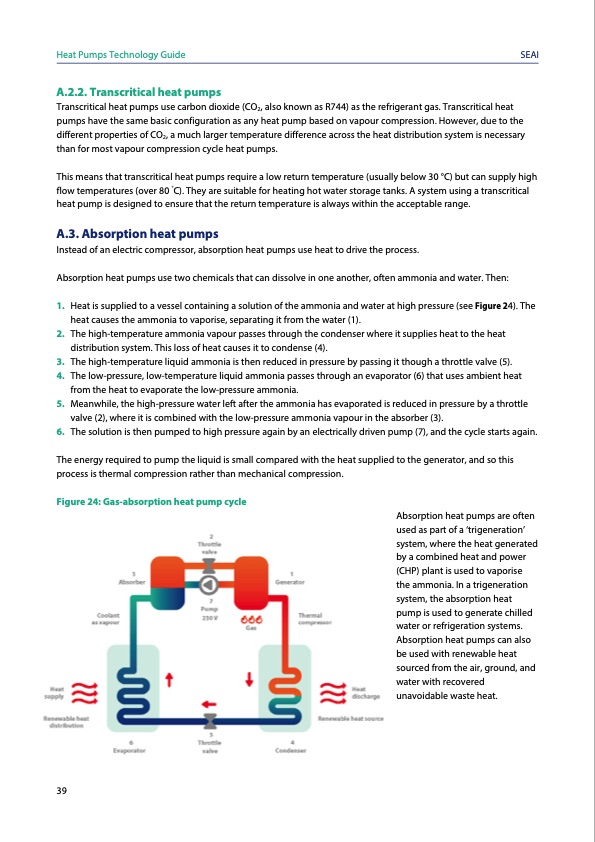
PDF Publication Title:
Text from PDF Page: 043
Heat Pumps Technology Guide SEAI A.2.2. Transcritical heat pumps Transcritical heat pumps use carbon dioxide (CO2, also known as R744) as the refrigerant gas. Transcritical heat pumps have the same basic configuration as any heat pump based on vapour compression. However, due to the different properties of CO2, a much larger temperature difference across the heat distribution system is necessary than for most vapour compression cycle heat pumps. This means that transcritical heat pumps require a low return temperature (usually below 30 °C) but can supply high flow temperatures (over 80 °C). They are suitable for heating hot water storage tanks. A system using a transcritical heat pump is designed to ensure that the return temperature is always within the acceptable range. A.3. Absorption heat pumps Instead of an electric compressor, absorption heat pumps use heat to drive the process. Absorption heat pumps use two chemicals that can dissolve in one another, often ammonia and water. Then: 1. Heat is supplied to a vessel containing a solution of the ammonia and water at high pressure (see Figure 24). The heat causes the ammonia to vaporise, separating it from the water (1). 2. The high-temperature ammonia vapour passes through the condenser where it supplies heat to the heat distribution system. This loss of heat causes it to condense (4). 3. The high-temperature liquid ammonia is then reduced in pressure by passing it though a throttle valve (5). 4. The low-pressure, low-temperature liquid ammonia passes through an evaporator (6) that uses ambient heat from the heat to evaporate the low-pressure ammonia. 5. Meanwhile, the high-pressure water left after the ammonia has evaporated is reduced in pressure by a throttle valve (2), where it is combined with the low-pressure ammonia vapour in the absorber (3). 6. The solution is then pumped to high pressure again by an electrically driven pump (7), and the cycle starts again. The energy required to pump the liquid is small compared with the heat supplied to the generator, and so this process is thermal compression rather than mechanical compression. Figure 24: Gas-absorption heat pump cycle 39 Absorption heat pumps are often used as part of a ‘trigeneration’ system, where the heat generated by a combined heat and power (CHP) plant is used to vaporise the ammonia. In a trigeneration system, the absorption heat pump is used to generate chilled water or refrigeration systems. Absorption heat pumps can also be used with renewable heat sourced from the air, ground, and water with recovered unavoidable waste heat.PDF Image | Heat Pumps Technology Guide

PDF Search Title:
Heat Pumps Technology GuideOriginal File Name Searched:
Heat-Pump-Technology-Guide.pdfDIY PDF Search: Google It | Yahoo | Bing
CO2 Organic Rankine Cycle Experimenter Platform The supercritical CO2 phase change system is both a heat pump and organic rankine cycle which can be used for those purposes and as a supercritical extractor for advanced subcritical and supercritical extraction technology. Uses include producing nanoparticles, precious metal CO2 extraction, lithium battery recycling, and other applications... More Info
Heat Pumps CO2 ORC Heat Pump System Platform More Info
| CONTACT TEL: 608-238-6001 Email: greg@infinityturbine.com | RSS | AMP |